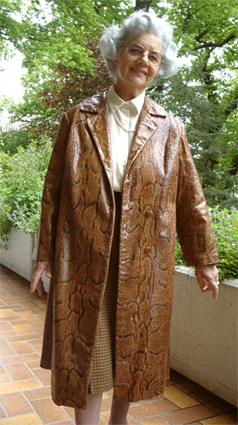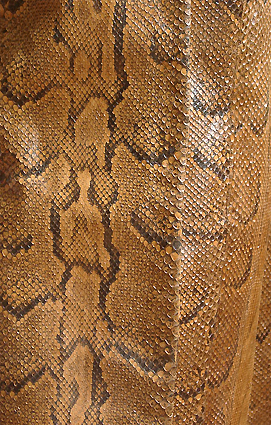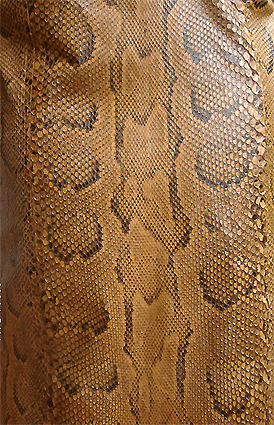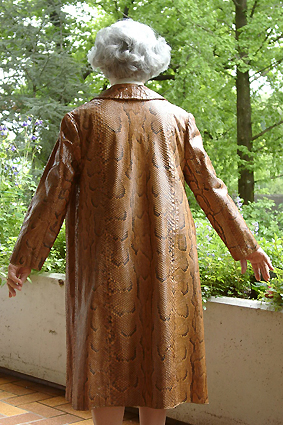THE MAKING OF A COAT
FROM PYTHON SKINS
INTRODUCTION
This
story is part of my memoirs titled THE SUDAN where we lived from 1961
until
1964. The
Sudanese Embassy replied favorably to my application for a Senior
lecturer's
post at the Khartoum
Technical Institute. I signed a provisional contract that still
had to be
approved by the Ministry of Education of Sudan. At
the Khartoum Technical Institute I was lecturing some 14 regular
hours plus 12
hours of the coaching new lecturers and students preparing for their
re-examination. I
also was appointed the assistant to a professor of the University of Khartoum for a total
of 9 lecturing hours. Thus the lecturing kept me really busy for the
three school years that ended with the one of 1963/4. Vesna, our 9-year
old daughter, continued her primary education at the 4th class at Combony Sisters School in Khartoum. Within
short time my wife Ljiljana got accustomed to the local climate and
customs as well as to all the normal house chores in the surrounding.
She has played as a perfect
host at several parties that were held in our flat on the 4th floor
of a large
block of flats at Hai el Matar (means "Airport Compound").
#
# #
THE
MAKING OF A COAT FROM PYTHON SKINS
Soon
Ljiljana would find enough spare time to pursue her seamstress hobbies.
Mrs. Mira Diklic, the wife of our neighbor and compatriot, persuaded
her that they should jointly produce lady coats for themselves made out
of
python's skins. Mira used to go to Omdurman, the native
township of Khartoum, to search in the native shops for local
products. On one occasion she found in an insignificant shop many
dozens of dried dessert python skins stored there. The Yugoslav
Government sponsored
a leather manufacturing plant in Khartoum that started with
the production about the same time.
The tannery main purpose was to process cattle's rawhides for the needs
of leather crafts. Later the plant management found out that the
rawhides
were not good enough for processing at all. The rawhides have had too
many bruises, cuts or other defects caused by the harsh environment
in that the cattle were domesticated. Thus the expensive equipment
stood idle
for most of the time after. Then Mira got the brilliant idea to try
tanning
python skins
there.
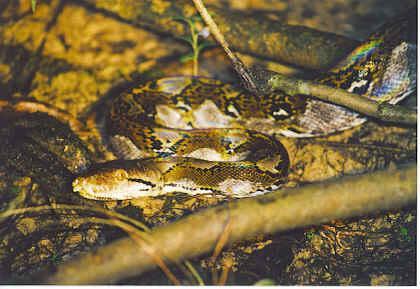
Desert Python found in the State of
Sabah
of the Sudan
>From URL <www.virtualtourist.com> Frockland's Pictures

The kids of the Sudan held quite a
long desert python
From
URL <www.virtualtourist.com> Frockland's Pictures (Postcard)
The desert python lives in the deep pipe-like pits that could be
recognized
on the surface as a round hole only. The snake crawls
out through that hole when the air outside is cool enough. The
trader spoke a passable English and explained to me in full seriousness
how the
hunters catch a python.
The python's exit hole has to be widened enough that a slim man's legs
should fit into the pipe up to the wider hip part. The bare legs are
smeared on with animal
lard up to man's short pants. The python would start crawling up the
hiding pit blocked by bait-man's legs at the outlet. The snake smelling
the fat and
heat starts swallowing both the legs as it ascends to the opening.
Once python's
wide gaped jaws reach man's hip the snake has no strength to withstand
being pulled out
to the surface by the standby hunters of the bait-man. A stretched
snake to
its full length has no power to wind up around anything. Thus it is an
easy task to
cut it open all the way up along the belly and to kill it
simultaneously. Subsequently
the bait-man is released unharmed from the snake's clamped jaws. Thus
the python carcass can be peeled off without making any scratch
or damage to the raw skin.
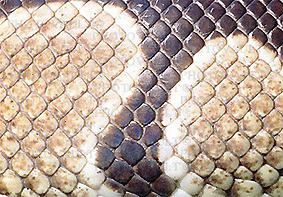
Detail of the skin of a Python Regius
One
day both ladies decided to venture to this shopkeeper in Omdurman. They
returned home with a
dozen of dry python raw skins rolled in as they were rough and not
scoured properly.
The tannery plant specialists were happy to help and took care of the
skins
by cleaning and scouring them properly first. Then the skins were
tanned to be wet
stretched and fixed onto large glass panes to dry in hot air. The
result of this procedure was a real perfect
product making th e skins flat and equally thick to be used for the
forming
and sewing a
lady's coat. The ready skins were about 4 to 5 meters long, the width
varied between 40 and 50cm and had
beautiful markings
at their inner sections. The two ladies
started their joint efforts to tailor, cut and sew several skin
parts together. My only help to
their flawless team work consisted to apply the special glue
"UHU" and to spread it into the seams. Thus the seams stayed flat when
the glue dried.
Left the open coat made of python skins and
near view when closed right (2004)
Both the
coats made of python skins were completed before Christmas 1963 and the
ladies were mighty proud of their achievement. However they never did
put on their
python coats in the Sudan due to the rather hot climate there.
Nevertheless
there was a lot of
admiration from other less active ladies. The
result of their efforts was the fine looking lady's long coat as shown
in
the pictures.
Left the close up view and the full back
view of the coat made of python skins right
EPILOGUE
We
arrived to Salzburg from
Khartoum by end of February 1967 and
there was still winter here. We did not have any proper winter clothing
and
the winter sales were
over in Salzburg already.
Ljiljana had
to put on her "python" coat and went searching through shops that
were recommended for some winter garments. She visited one shop after
the other that were still offering
winter cloth but all at the exorbitant prices though. Salespeople
seeing
her wearing an
exceptional and obviously expensive coat had thought that she was
looking for some
extraordinary garments only.
Disappointed
with such results Ljiljana ventured through the Getreidegasse that was
the Corn Street in the Old
City of Salzburg. There she overheard the following discussion of two
boys who
were following her talking aloud: "You don't believe that this coat is
made of REAL snake
skins?" asked the first one. The other one replied: "Silly you, it is
made of
synthetic material. It's true!" - Frustrated Ljiljana sped up to
enter the next
nearby shop instantly.
Several
months later Ljiljana took her "python" coat to a concert held in the
Great Festival Hall. After the performance she vent to collect her coat
from
the wardrobe. There the woman handing her the coat asked politely: "Is
this a
real snake's coat?" Ljiljana took her hand and stroke it lightly
against
skin scales. Poor woman whimpered a little bit and exclaimed: "It's a
real
snake!"
Then
came times when it was dangerous to carry any garments made of wild
animals
fur or skin. Color would be sprayed over any fur or skin with aim to
cut or to scratch on it thus totally ruining the valuable item. Since
those times Ljiljana did not put on her "python"
long coat until the day I took the pictures shown here.



